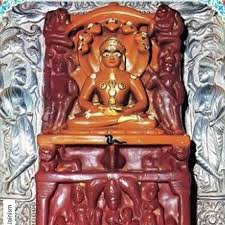Introduction
Bhateva Parshwanath Jain Tirth is a peaceful and powerful pilgrimage site located in Chanasma, in the Patan district of Gujarat. It is known for its unique sand-made idol of Bhagwan Parshwanath, created with divine blessings and full of spiritual energy.
This temple is visited by devotees from across the country who come to witness its beauty and experience the miracles associated with this ancient Jain Tirth.
The Main Idol – Bhateva Parshwanath
- The Mulnayak (main idol) is of Bhagwan Parshwanath, 23rd Tirthankara.
- The idol is 23 cm tall, catechu-colored, and sits in Padmasana (lotus) posture.
- The idol features:
- Seven-hooded serpent (Sheshnaag) above the head.
- A waist-band (kandora) and carvings of Dharanendra and Padmavati nearby.
- A rare image of Ambika Devi with a child below the main idol.
This idol is believed to be originally made from sand, later turned into stone by the blessings of Devi Padmavati. The idol’s history is closely linked with devotion, divine power, and miraculous events.
Origin Story – The Power of Devotion
The Story of King Prajapal and the Sand Idol
Long ago, King Prajapal of Champanagari and his minister Budhisagar went on a horse ride. Their horses ran so fast they ended up in a dense jungle.
As night fell, they stopped under a tree to rest. At midnight, they heard music and discovered Nargosh Muni had attained Kevalgyan (complete knowledge). The king and minister listened to his teachings and took a vow: they would not eat or drink until they worshipped a Tirthankara idol.
In the morning, they couldn’t find a temple nearby. The minister made a small idol of Parshwanath Bhagwan out of sand, but they couldn’t do Abhishek (ritual bath) because it was fragile.
They prayed with full devotion, and Devi Padmavati appeared. She turned the sand idol into stone. That divine idol came to be known as Bhateva Parshwanath.
Ancient Connections and Later Miracles
The Prince Who Was Healed
Thousands of years later, King Bhudar of Patan had a son who was blind, dumb, and seriously ill. Acharya Dharmaghoshsuriji advised the king to use the holy water from Bhateva Parshwanath’s Abhishek on the child.
After the ritual, the child was fully cured—another miracle showing the idol’s divine power.
Worshipped by Devas in Heaven
This sacred idol was later taken to Devlok (heaven), where it was worshipped by celestial beings for 5,25,000 years. Eventually, Shravak Surchand from Bhatuar village received the idol through divine blessings and installed it in Chanasma under the guidance of Acharya Ajitsimhasurishvarji in Vikram Samvat 1335.
Art and Architecture
The temple is rich in sculpture and spiritual energy. Key features include:
- The main idol made from sand, a rare and sacred creation.
- Carvings of Dharanendra, Padmavati, and Ambika Devi.
- Other temples in the complex include idols of Shri Sheetalnath Bhagwan and Shri Adinath Bhagwan.
This temple stands grandly on the Mehsana–Harij highway and is said to be one-of-a-kind. Devotees believe just seeing the idol brings peace and blessings.
Temple Facilities & How to Reach
- Location: Just 1 km from Chanasma Railway Station, on the Mehsana–Harij road.
- Nearby Facilities:
- Dharamshala for lodging
- Bhojanshala for food
- Pathshala for Jain education
- Upashraya and an ancient Gyan Bhandar (library)
Scriptural References
This tirth is mentioned in several Jain scriptures:
- Shri Parshvanath Naammala
- Shri Parshvanath Chaityaparipati
- Shri Bhateva Parshvanath ki Utpatti
- Shri Bhateva Parshvanath Lavani
Also, idols of Bhateva Parshwanath can be found in:
- Kalikund Parshwanath Temple (Santacruz, Mumbai)
- Jiravala Tirth
- Vasupujyaswami Mandir (Surat)
- Bhiladiyaji Tirth
- Kareda Tirth
Temple Trust and Contact Info
Managed by:
Shri Chanasma Jain Mahajan Ni Pedhi
Moti Vaniyavad, Chanasma – 384220, District: Patan, Gujarat
FAQs About Bhateva Parshwanath Tirth
What is special about Bhateva Parshwanath?
The idol was originally made from sand, and later turned into stone by Devi Padmavati. It is also known for healing miracles.
How old is the temple?
It was installed in Vikram Samvat 1335 (around 13th–14th century CE), making it an ancient and sacred tirth.
Where is Bhateva Parshwanath located?
In the town of Chanasma, District Patan, Gujarat – just 1 km from the local railway station.
Are there any other temples nearby?
Yes, there are temples of Shri Adinath Bhagwan and Shri Sheetalnath Bhagwan within the same complex.
Is this tirth mentioned in Jain scriptures?
Yes, it is referenced in many Jain texts like Naammala, Chaityaparipati, and special works dedicated to Bhateva Parshwanath.
For an extensive list of Parshwanath temples and their significance, visit the 108 Parshwanath Names List.
